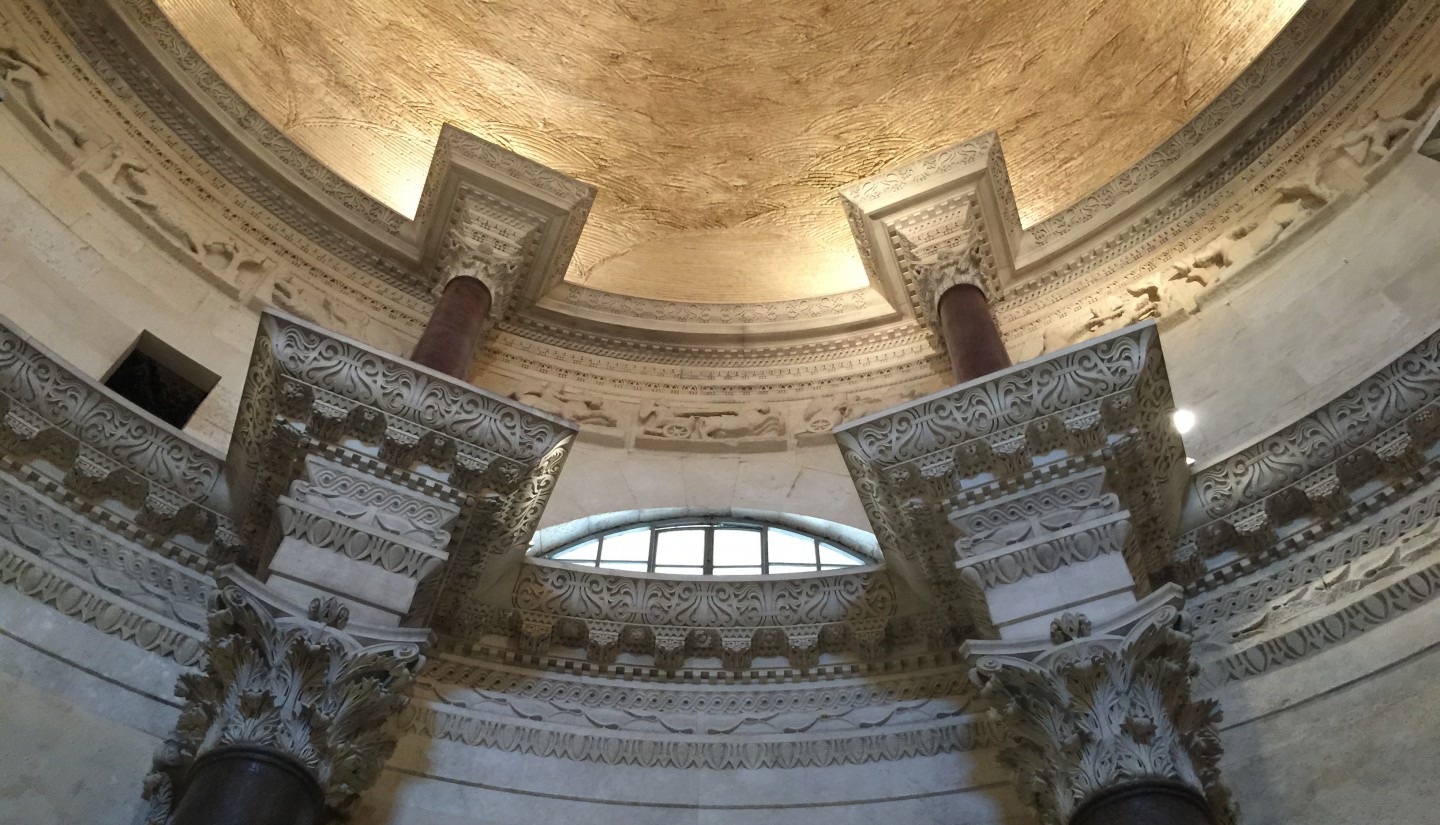Overall 4**** A hotly-disputed four, given the points below.
Display 3*** Let down by minimal labelling and not much context. Very much the academic art-historical approach – given where it is, not surprising.
Access 4**** It’s at Yale in New Haven CT, so a long way to go – we drove for 2 hours from Boston! But it’s free and there is easy parking near.
Atmosphere 3*** Studious art-historical setting. Given what they have, they could make of their unique Roman exhibits.
Other 6****** This rating is in recognition of the uniqueness of the finds – the only legionary shield – and its decoration intact; the only figurative synagogue decorations; the only intact Mithraeum decorations; and one of only three sets of cataphract armour!
In 1920 a British Army unit occupying former Ottoman territory stumbled across wall paintings in the ruins of the City of Dura Europos on the banks of the River Euphrates. They notified the eminent American archaeologist Professor Breasted of the University of Chicago.
Dura had been founded on the upper Euphrates by the Hellenistic ‘Successor’ Seleucids around 300BCE, and had been taken over by the Parthians in C2BCE, becoming a major fortified crossroads of East-West trade. It was captured by the Romans in AD166 during Verus’ Parthian War. It then formed a frontier garrison on the Euphrates for the Romans with strong influence and troops from the Roman ally of Palymra. In 256AD the Sassanids, the successors of the Parthians in the East, besieged Dura successfully and sacked it.
The excavations at the site at Dura in the 1920s and 1930s were led by a Yale University team lead by the Russian emigré Prof Rostovtzeff and the French Academy of Inscription and Letters. Owing to the siege that led to the end of Dura and its abandonment, many remarkable and unique finds dating principally from the Tge Third Century AD were uncovered. The Romans had reinforced their most vulnerable sector on the west of the city by piling up earth and sand behind the walls, thus hermetically sealing a whole sector of the city. Furthermore, the Sassanids and Romans mined and countermined under a tower which then collapsed, entombing both Roman and Sassanid soldiers.
The Yale expedition took their share of the finds home and these are well displayed in the Yale Art Gallery in New Haven, Connecticut.
A connecting theme of the Yale displays is the co-existence of many cultures and religions in this Roman frontier city. There is evidence of Latin, Greek, Palmyrenean, Hebrew, Safaitic and Pahlavi being spoken. Turning to religion, there are temples to the eastern gods of Syria, the local deity Dolichenus being associated with Jupiter from the Roman Pantheon. There is an early example of a Christian house church with a baptistery. There is synagogue with painted ceiling tiles, showing figurative art previously not recognised in Jewish art. Perhaps most extraordinary of all is a well-preserved Roman Mithraeum intact paintings, set up by a unit of Palmyran horse archers. Finally, there is a painting of a dedication by a Roman tribune and his unit to three deified Emperors in military uniform. Taken together, this is a stunning assemblage of mid-Third Century AD religious items and paintings reflecting the great diversity of beliefs and religions in the Empire at this period.
The other extraordinary assemblage of finds is the military remains. There is a unique legionary semi-cylindrical scutum and a large oval auxiliary shield. Both are painted, with the scutum preserving remarkably clear decorations. The display does not offer any interpretation of the motifs on the scutum, but we think the lion suggests an association with Legio XVI Flavia Firma which was based in the Province in that era and had proven tunnelling expertise from the port of Selucia.
Alas, the oval shield has not been so well preserved, but watercolour paintings of this and two others made at the time of the excavations fortunately record the very intricate and colourful patterns.
Even more remarkable are the circumstances of the finds. Deducing what happened from the excavations, it seems that in AD265 the Sassanid besiegers dug a mine under a tower of the western wall of Dura. The Romans, hearing their approach, dug a counter-mine and broke in to the diggings. However, the Sassanids had prepared counter measures of pitch, sulphur and bitumen that gave off deadly gases in the confined space.
The Sassanids then seem to have piled up about 20 dead Roman soldiers, complete with their shields, into a barrier whilst they prepared to demolish the tower by setting fire to the props of the tunnel with more bitumen. The Sassanid soldier who set the fire put down his helmet and sword, but lingered too long and was overcome in his turn by the fumes.

There are many other interesting finds in the Museum including Palmyran sculptures and everyday items of life from the city.
Here are some more photos from this stunning set of finds.













